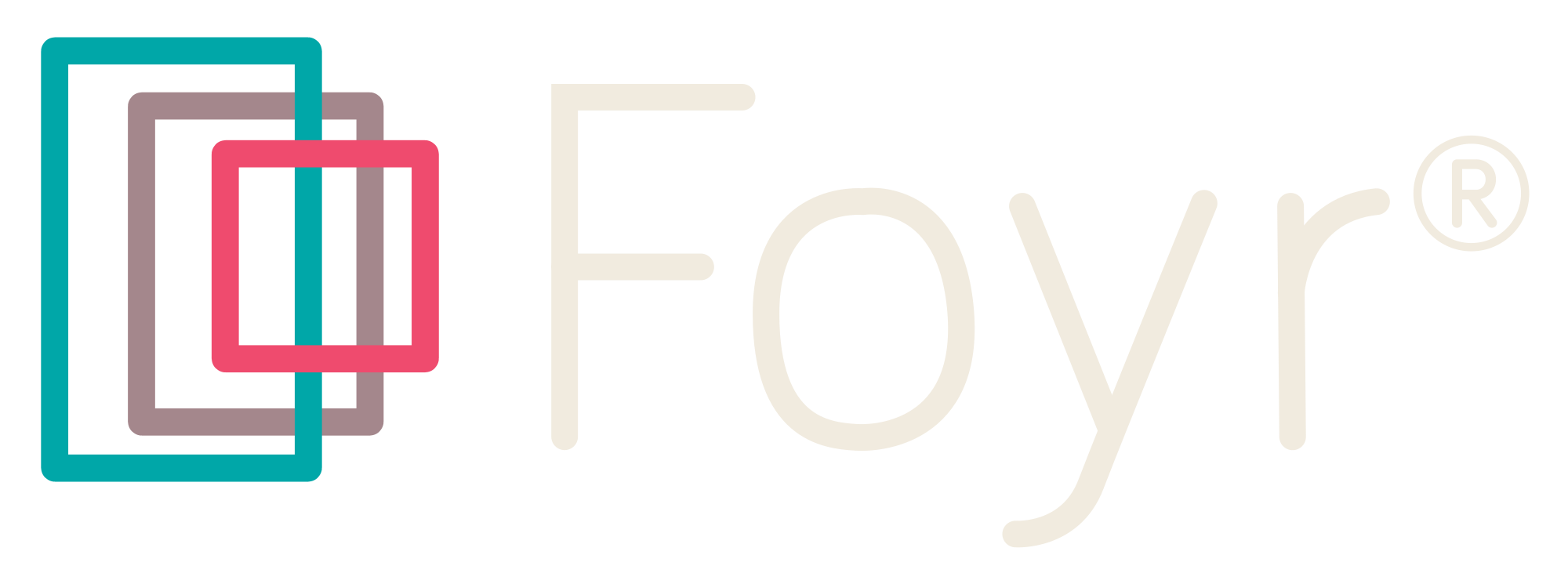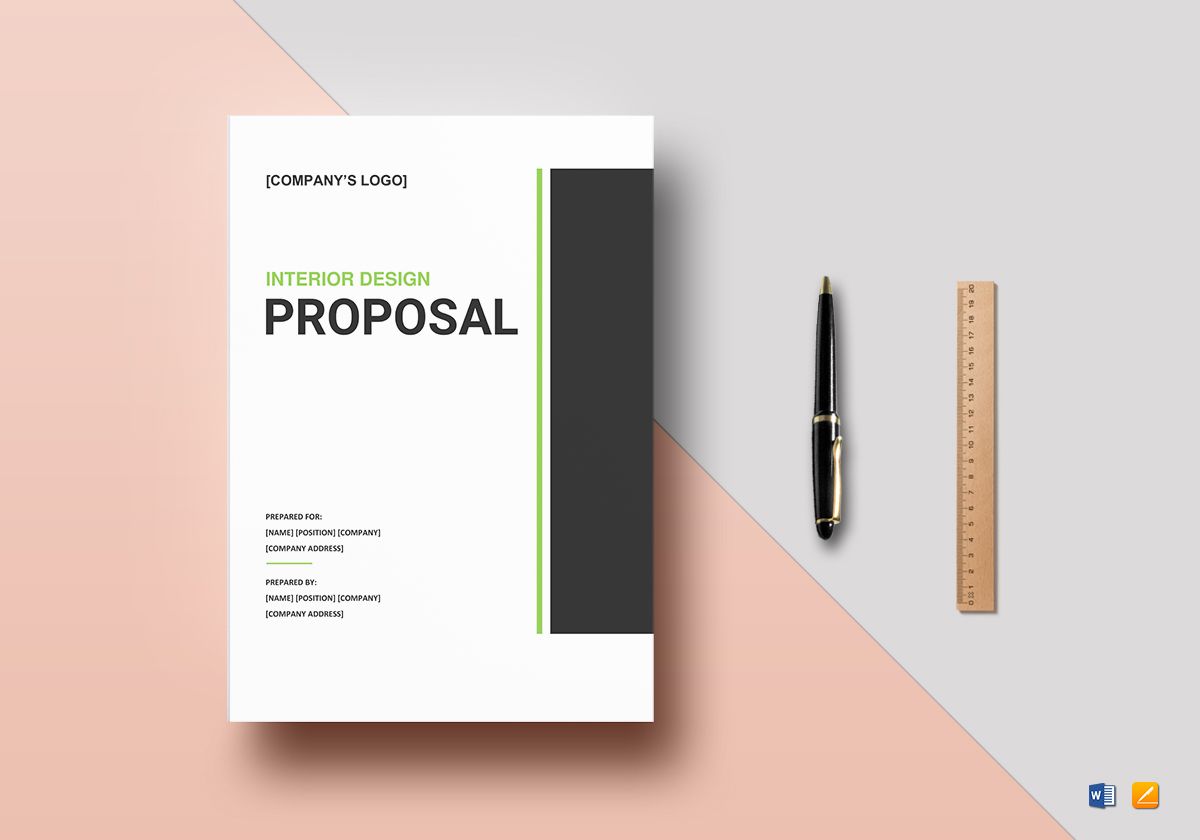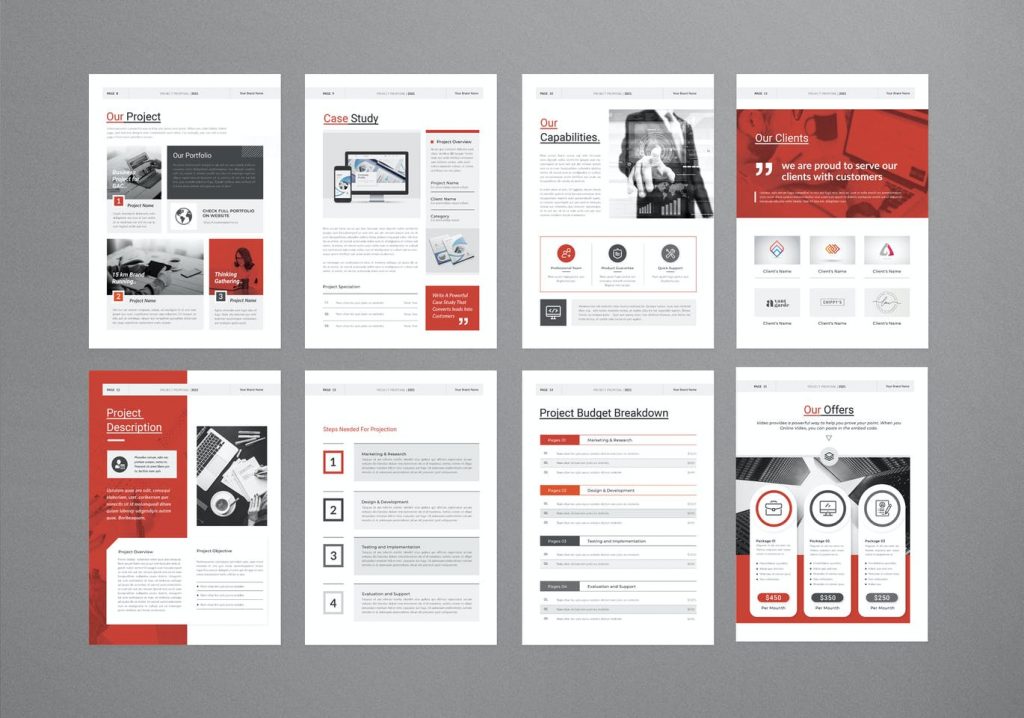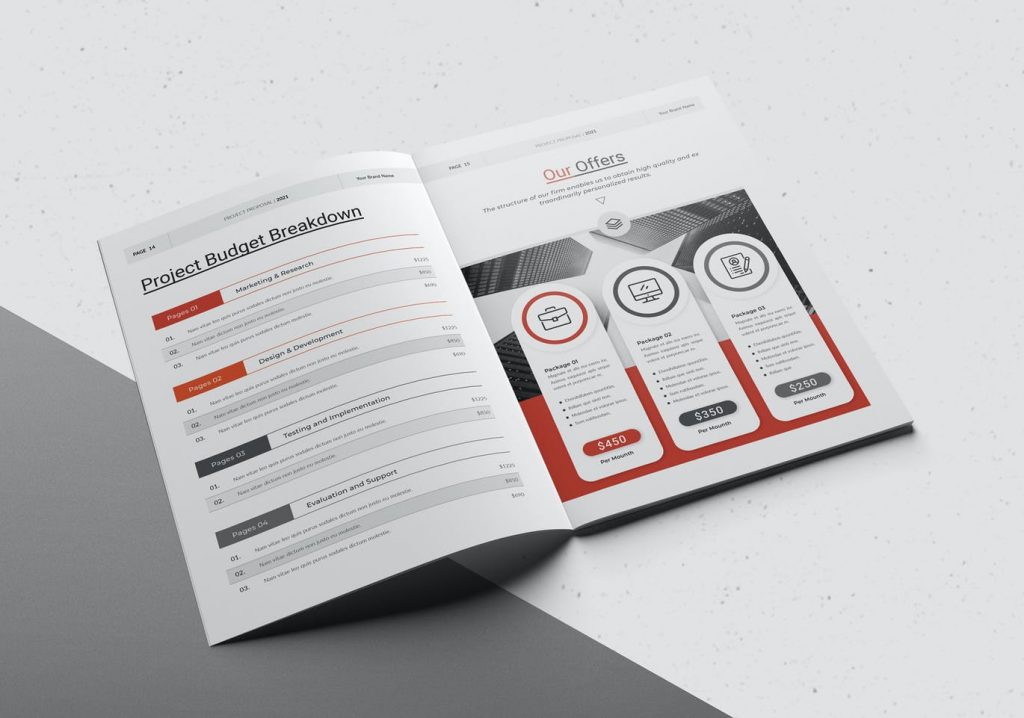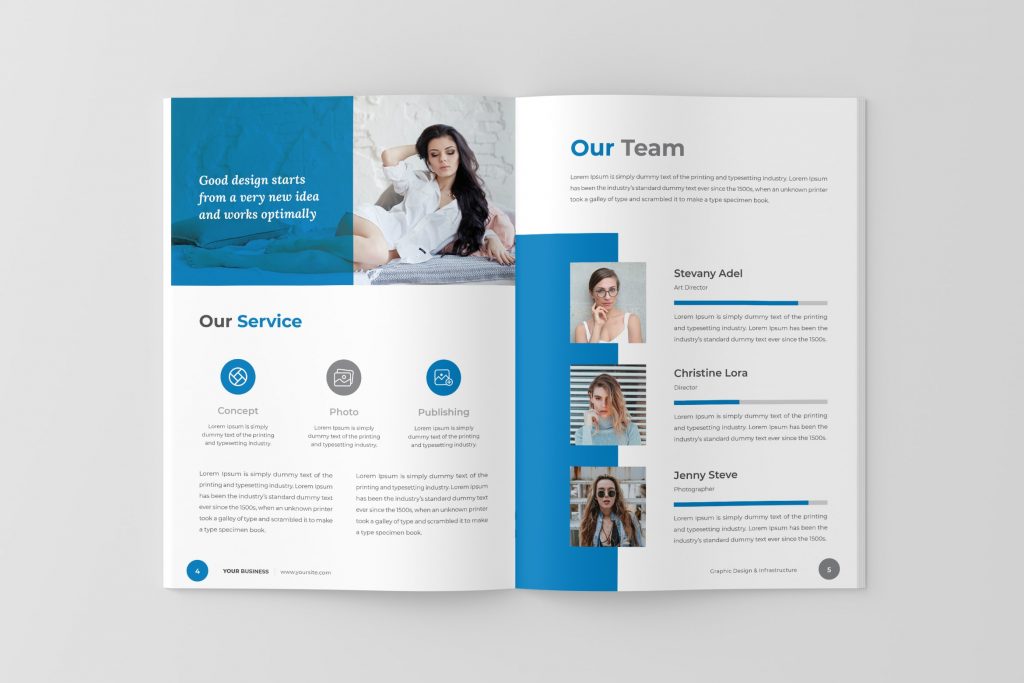Interior Design Proposal
Running a business is not an easy task. You need to understand how to sell effectively without seeming aggressive or becoming a ‘yes man.’ There needs to be a balance between what you have to offer and what prospective clients desire. No business can create a need for a product or service, but you can certainly create a want.
While this requires you to possess unparalleled expertise in your field to a certain extent, you also need to understand how to package, present, and price your services, and build a winning proposal. Before deciding to work with you, clients expect to go through a process of discovery (e.g., outlining the project scope) and ultimately receive a full business proposal that outlines exactly how your services will be fulfilled to benefit them.
Currently, there is a network of over 15800 interior decorators in New York consisting of both interior design firms and freelancers. It is a tough competition but very easy to conquer if you have the right tools at your disposal.
Without a well-crafted interior design proposal template your clients might be unclear about exactly which services you can provide, how much the entire project will cost, and a realistic timeline for completion. In theory, drafting a transparent interior design contract may seem daunting, but the actual process of creating an interior design proposal to impress a client will seem much simpler by the end of this article.

Image Credit: envato.com
Today, we are about to share with you a step-by-step guide to drafting interior design proposals that outline the scope of work, marks the milestones, specifies the deliverables, defines your understanding of the expectations from potential clients, and still leaves room for contingencies.
There are lots of resources to help guide you in this step-by-step process to help produce a winning interior design proposal template. We’ll break down exactly when to prepare your proposal, the sections you should include, how to show your deliverables, top tips for your proposal creation process, and a free proposal template to get you successfully started with offering interior design services with a top-notch business proposal for prospective clients.
If you’re ready to send out an interior design contract and win your first few clients as a freelancer or an interior design firm, let’s get started!
Also, Read: 20 Best Client Presentation Tips for Interior Designers
When Should You Provide an Interior Design Proposal?
Don’t make the mistake of sending a business proposal to your client immediately after they reach out to you. Similarly, you also don’t want to provide your pricing too early. The process of earning new business can take time and patience. In most cases you’ll likely find that the path from a new contact to a converted new client looks something like this:
- A lead is referred to you or reaches out by finding your contact information somewhere.
- You schedule an introduction call with the potential client to understand their specific vision and needs.
- On this call, you are able to gather information about their new project, estimated budget, and expected timeline.
- After the call, you conduct the necessary research before drafting a business proposal.
- You set a final meeting to present the formal proposal to the prospective client and leave this document with them for reference after presenting a vague idea of the deliverables and discussing payment terms.
Although they do cover high-level concepts and summaries, business proposals also include specific details that are customized to each prospect’s needs. You will only be able to understand and address these details after spending enough time researching their unique situation.
If a prospective client pushes you to provide an interior design contract right away (especially if it’s before you’ve even had a call) then you might need to politely push back, and consider it a red flag. It’s not fair or appropriate to skip a vendor’s deliverables just because you’re in a hurry.
You can often tell how a client will treat you by how they interact during the sales process. If they just want to discuss design fees and see your design project proposal, but are unwilling to consider the pricing table, design concepts, and your team members or freelancers required to fulfil the contract, then you might be better off telling them that you’re not the right fit for the project.
It is not about catering to every client but finding the right clients who will stick with your interior design business in the long run because it benefits both parties equally.
7 Must-Haves in an Interior Design Proposal
There’s a lot of advice about how to create proposals for the real estate sales process that effectively win new interior design businesses. However, this advice doesn’t apply to every industry. Below, we’ve curated some of the most important aspects of an interior design business proposal and provided further context on why they’re important.
Skipping one of these sections might cause you to confuse a prospective client with another, or potentially miss an important piece of information. It’s critical to remember that design project proposals serve you (the provider) just as much as the client.
You can use the proposal to protect yourself against potential pitfalls like disputes about billing or project scope. Including each area below in your comprehensive proposal is simply a best practice when laying the groundwork for a mutually beneficial relationship between a new client and the interior design firm.
Lastly, note that the sections below are not listed in a particular order because you may want to strategically move them around based on an individual client or as you tweak your interior consulting proposal template to optimize its flow and layout.
You’ll likely be speaking directly from the docs when conducting a final presentation, and that will be the best time to make notifications about how well it works and what you would like to change in the future.
You may even discover potential points to alter in your final proposal letter before adding your e-signature to the letter template or signing the dotted line on the interior design contract.
Quick Read: How To Create Interior Design Packages for Your Business?
Image Credit: envato.com
1. Summary
- Use the first section of the proposal to simply reiterate what you’ve heard throughout the process of discussing expectations with your client so far. Include a high-level overview of what needs to be done and the approach that will be taken. It is also appropriate to summarize your experience and expertise along with your background that makes you the best fit for the project. The summary is similar to a cover letter in the sales process to acquire a new project or business.
- It is also smart to state specific things about your client in this section. For example, mention their design preferences, constraints, budget, etc. as per your discussions. It not only shows that you paid attention and are willing to devote your time and resources but also provides a documented letter template to protect you from liabilities.
- Overall, think of your summary as the place where you’ll make sure it’s clear to the client that you fully understand what to do and what’s most important to them. The precise project details will follow in later sections.
2. Goals
- This is an area to be very thorough with your descriptions of what the interior design project’s conclusion will look like, and what your client should expect once you’re finished. Explicitly state exactly what will be accomplished when the workflow has come to an end, and be sure to also list what might remain done due to work that is dependent on others (or that will be completed by the client themselves).
- Use the goals section to ensure that your client is completely clear and that their expectations are realistic. If you or the client has miscommunicated then this is likely one of the main areas where differences of opinion will surface regarding design fee, workflow, payment terms, design concepts, etc. It offers an opportunity to tweak your proposal letter or make modifications to the 3D web design that depicts the expected design project.
Recommended Read: Setting Goals for Interior Design Business
3. Work examples
- Include the best samples of your interior decorator projects from your larger portfolio directly within the proposal that showcase your design process and scope of work that directly pertains to the prospective client. Go the extra mile to add a few sentences along with the before and after pictures of the layout that describe what you did for the client, what their goals were, and the outcome of your interior design services.
- Add visual details in a web design proposal and, if possible, include a direct quote from the client with their picture as a transparent testimonial on your deliverables. This web design proposal shouldn’t be a 3D model of your client’s real estate, but rather a presentation of your past projects.
- Ultimately, your potential client just wants to know that you can deliver the design concepts they’re asking for and that your interior design services will be worth the design fee. Pick your work examples carefully based on what you’ve learned about the client through the discovery process. It is important that they resonate with at least 40% of your samples in some way to come to the inevitable conclusion that your interior design firm is the only choice for their new project.
- Some professional interior design businesses also add references to their proposals, which is a great way to build trust and prove that you have a successful track record of completing interior design projects with similar clients. It also tells them that your sales process has proven validity, your pricing table is competent, your vendors are reliable, your team members put their best foot forward, and any freelancers you hire will live up to the promises made by your firm, and in extension will fulfil the expectations of new clients.
Related Read: 12 Ways To Create Best Architecture Portfolio for Designers
4. Scope of work
- Every successful engagement for an interior design project, no matter how small, will start with a properly defined scope of work. It’s imperative that you don’t skip this step in your business proposal, and that you work hard to capture and thoroughly document each relevant detail of workflow and execution.
- The scope of work will define exactly what you promise to do for the client during the course of your engagement. Throughout the design process, you can continually refer back to this scope of work as a mutual agreement about the services that would be provided, and how much time will be invested at each stage.
- You can be very detailed with estimates of hours, who is responsible for which aspects of the project and their exact tasks, workflow, key milestones, project manager expectations, which team members need to be provided notifications, the order of the steps, and more.
Quick Read: Guide To Interior Design Project Management
5. Client expectations.
- It’s entirely fair to list the type and detail of communications with the new client or for a new project with a long-time client. This section could include the mode and frequency of communication, the number of revisions offered on the web design, how long you will wait for client input before moving to the next section of a project, and every detail that could affect the project.
- Be careful not to be too lengthy or inadvertently insult the client, but you should definitely be thorough enough to let them know that you will take the design process seriously and expect the same respect from them.
Suggested Read: 10 Best Client Management Tips for Interior Designers
6. Total price
- Quoting the design fee is one of the scariest parts of any proposal! However, there is an easy way to make this whole process less intimidating. Before you get to the final price, list each itemized service.
- Breaking out each portion of the expenses in a pricing table will help the client understand each factor of the total price and how it represents a fair amount for the time, experience, tools, services, vendors, and other elements that you need to deal with in order to fulfil their expectations.
Image Credit: envato.com
7. Terms
- The terms of your interior service can be concise unless you’ll be using a full legal contract (which can be sent separately). Essentially, you just want to cover your payment terms and the mode of transaction. Contactors typically set payment terms that are 15, 30, or 45 from the date that services are rendered. Additionally, you’ll want to clearly explain if you accept credit cards, ACH, checks, or other types of payment.
Suggested Read: Interior Design Client Questionnaire
Top 10 Tips for Writing a High Impact Interior Design Proposal
Now that we’ve covered exactly what you should put in each section of your interior design proposal template, let’s review a few expert tips on how to make your business proposal stand out with a superior sales process.
1. Design it well, because it’s a reflection of you and your skills as an interior decorator. Use a nice design program to add professional images, branding elements, and your interior design business logo. If you plan to use one of the many free proposal templates, make sure that you introduce your own branding (images, logos, fonts,) so that new clients can distinguish your style.
2. Use an online e-signature tool like DocuSign, PandaDoc, or Fohlio to make the process of designing, sending, signing, and receiving your proposal much easier for everyone involved.
3. Have clear descriptions of your services and packages. Make sure to enunciate the payment terms since some designers get paid as a percentage, while others prefer an hourly fee. This should be noted in the Pricing section of the proposal, and clients may legitimately pose questions about any specific portion of the pricing table or overall fee structure.
4. Understand your client well, and make sure that you’ve had a clear conversation to learn their taste, needs, preferences, and ultimate interior design goals. A proposal that speaks directly to your client’s needs will be well received and definitely stand out against that of your competitors.
5. Be specific about the details, especially if you detect red flags or contradictions during the initial communications. Having a transparently detailed business proposal signed by both parties will benefit you as well as the client.
6. Add stipulations for potential deadlines, expectations, extensions, and payment terms, or how the terms of the agreement might change with certain circumstances as a contingency.
7. If your client will be responsible for specific parts of the project, ensure that this has been clearly communicated.
8. Use a template that can be applied repeatedly with minimal changes. Don’t create a new proposal from scratch each time you have a new client or potential deal.
9. Send your proposal to friends, family, or professional colleagues for review before using it with a real client or prospect. They may be able to offer valuable feedback.
10. Continue working on your proposal over time, making adjustments and tweaks as necessary.
Related Read: How To Create A Successful Interior Design Website?
Image Credit: uicreative.net
High-Impact Interior Design Proposal Template
In the section for design project proposal below we have provided a jumpstart for creating your letter templates and consulting proposal templates by outlining each specific area you should cover and providing some verbiage that you can tweak to make your own.
Summary
Prepared for: NAME | Prepared by: NAME
We appreciate the opportunity to provide this quote for NAME, and we hope to earn your business by thoroughly demonstrating our knowledge of your needs, proving our qualifications and credibility, and providing a fair estimate of the total services to be rendered.
We take pride in helping clients turn their vision into reality on time, and on budget. We promise to bring a listening ear, a partnership mentality, and a proven process to our work together.
Recognizing that CLIENT is seeking GOAL, we hope to support the timely and professional completion of this goal.
Goals
CLIENT has stated the following as specific goals or priorities to be addressed through this project:
- Goal #1
- Goal #2
- Goal #3
Work Examples
We have over X years of experience serving a variety of clients in the INDUSTRY or RESIDENTIAL space. We’re proud of our legacy that has been built through hard work, an efficient approach, smart planning, and deep industry knowledge.
The examples below were selected for their relevance to the CLIENT’s project, and show how we executed similar projects from concept to successful completion.
- Example #1
- Example #2
- Example #3
Throughout our years in business, we’ve built partnerships with numerous clients, and we’re happy to provide credible references listed below:
- Reference #1
- Reference #2
- Reference #3
Scope of Work
In support of CLIENT’s goals, we propose to provide the following services:
- Goal #1
- Detail
- Detail
- Detail
- Goal #2
- Detail
- Detail
- Detail
- Goal #3
- Detail
- Detail
- Detail
Client Expectations
To ensure a mutually beneficial relationship, and one in which both parties contribute equitably, we expect that CLIENT will be able to either provide the following or find an acceptable substitute that does not place an undue burden on us.
- Expectation #1
- Expectation #2
- Expectation #3
Total Price
The following itemized list and total price represent the total sum of costs incurred by CLIENT for the services rendered (as defined in the scope of work).
- Service item #1
- Service item #2
- Service item #3
- Service item #4
Terms
We propose the following payment terms:
- 50% of the total project fee is due once the contract is signed and is due within 30 days of receipt.
- The remaining balance is due upon the project’s completion and is also due within 30 days of receipt.
Also, Read: Profit Margins for Interior Design Businesses
Get Additional Resources for Your Interior Design Business
Need more guidance, resources, and hands-on training? Join us!
Foyr has built an entire online community to help interior designers grow their businesses through education, networking, job postings, and much more. Through our e-learning platform, you can access courses on a broad range of topics, including:
- Starting and scaling a business.
- Determining your pricing strategy.
- Finding your individual style.
- Identifying your ideal client profile.
Use the Foyr community to socially network with other interior designers by commenting, sharing content, and participating in courses.







